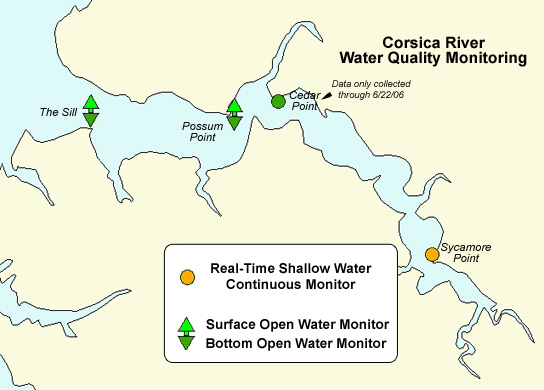|
|
Fish kill reports.On October 5, a fish kill of 70 fish was reported by the Advanced Placement Environmental Science Class of the Gunston School along the Corsica River . On October 10th, field staff from the University of Maryland's Chesapeake Biological Laboratory were conducting routine water quality monitoring and identified pockets of freshly dead fish on the river. Maryland Department of the Environment conducted a riverwide survey the same afternoon and counted approximately 2000 dead fish, mostly white perch. Water quality and plankton: late September . Karlodinium veneficum, a potentially toxic microscopic dinoflagellate organism, was identified at bloom conditions on the Corsica River during September with samples collected on the 19th (Sycamore Point: 26,670 cells per ml, Gunston Cove: 34,925 cells per ml and Centerville : 8,255 cells per ml) and the 26th (Corsica Boat Ramp: 54,000 cells per ml). Based on data from the Chesapeake Bay long- term routine water quality monitoring program network, Maryland Department of Natural Resources (DNR) rarely finds Karlodinium veneficum over 10,000 cells per ml and most commonly under 1,000 cells per ml by comparison. Water quality, plankton and toxins: October. From Sunday, 10/1, to Tuesday, 10/3, during the days preceding the first fish kill report, DNR's Sycamore Point Continuous Monitoring (Figure 1) showed daily peaks in chlorophyll a exceeding 400 ug per liter, indicative of high phytoplankton populations (Figure 2). Two water samples collected on October 3rd were examined by DNR laboratory staff and showed the highest bloom levels of the season on the Corsica River for Karlodinium veneficum were present (116,205 cells and 65,405 cells per milliliter). The samples were tested for karlotoxins at Dr. Allen Place's laboratory in the University of Maryland Biotechnology Institute's Center of Marine Biotechnology, Baltimore , MD, and showed sufficient toxin was present to kill fish (640-841 ng/L total karlotoxin).
Figure 1. Corsica River , Sycamore Point Continuous monitoring station in addition to the MDDNR's other monitoring stations on the Corsica R. Evidence for an algal bloom crash began on Tuesday, 10/3. From 10/3 through 10/6, chlorophyll a levels declined by more than 50% (Figure 2). Many plankton cells lyse under such conditions and with Karlodinium , any toxin in the cells gets released into the environment as the population crash occurs. Degradation of cell material by bacteria requires oxygen resources and the continuous monitoring data shows a steady decline in dissolved oxygen conditions during this period (Figure 3), however, oxygen levels in this location only dipped below 5 mg O2 per L very briefly from 10/4-10/5; 10/6 had a greater dissolved oxygen sag than any day in the previous week at levels below 5 mg O2 per L, conditions stressful to many fish. Figure 2. Corsica River , Sycamore Point Continuous monitoring station data for chlorophyll a (ug/L), 10/1-10/10/2006. Precipitation (inches) is indicated for each day, data from Sandy Point State Park .
Figure 3. Corsica River , Sycamore Point Continuous monitoring station data for dissolved oxygen (mg O2 /L), 10/1-10/10/2006.
Storm events on Friday, 10/6, and subsequent runoff were coincident with further declines in the dissolved oxygen resources in the surface waters; dissolved oxygen levels reached a minimum of 1.7 mg O2 per L at 11pm on Saturday October 7; dissolved oxygen levels also remained below 5 mg O2 per L all day Sunday October 8th except for a 15 minute period from 1:30 and 1:45 AM, coincident with a drop in salinity, evidence of freshwater runoff effects (Figure 4). Chlorophyll levels were holding steady near 20 ug/L this day, less than 5% of the peak levels for the last week and further indication of the algal population crash. Figure 4. Corsica River , Sycamore Point Continuous monitoring station data for salinity (ppt), 10/1-10/10/2006.
October 10th fish kill dominantly white perch. University of Maryland Chesapeake Biological Laboratory staff Eva Bailey indicated dead fish in small groups were present along the river this morning. Water on the river was described as tea colored with bubbles on the surface and dissolved oxygen levels were elevated near the river mouth but near normal upriver. MDE staff surveyed the river that afternoon and estimated 2000 fish dead, most fish were white perch. Water samples collected showed Karlodinium veneficum absent from two of the three sites and only at 762 cells per ml for the third site. The non-toxic dinoflagellate Heterocapsa rotundata was now increasing and varied from 127-28,575 cells per ml among the three samples. The events over the last week suggests a possible combination of impacts from algal toxins involved in the initial kill and stressful concentrations of dissolved oxygen in combination with algal toxin impacts extending the duration of kill events. The environmental conditions this year resemble those surrounding the September 2005 fish kill when an estimated 30,000-50,000 fish also died on the Corsica River (See DNR HABnews October 5, 2005 Corsica River Fish Kill: Die-off of algae leads to low dissolved oxygen and algal produced karlotoxin effects on fish https://eyesonthebay.dnr.maryland.gov/hab/news_100505.cfm ). Maryland Department of Natural Resources will continue to actively monitor and report on the condition of the river.
|

